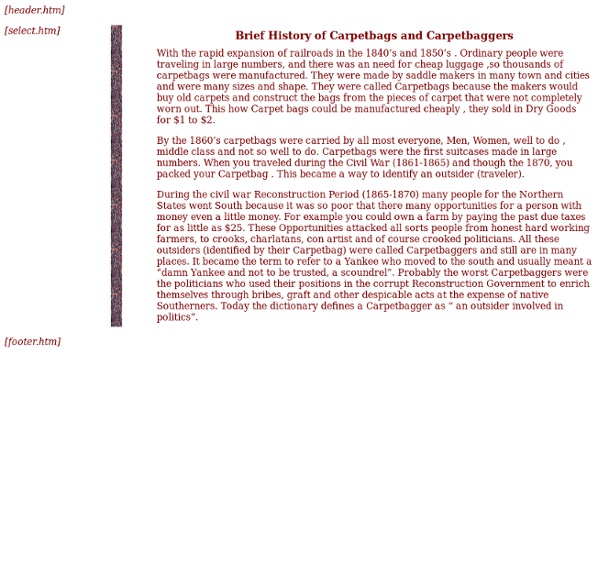



http://www.thecarpetbagger.com/history.htm
Slavery By Another Name Bento After the Civil War, former slaves sought jobs, and planters sought laborers. The absence of cash or an independent credit system led to the creation of sharecropping. Sharecropping is a system where the landlord/planter allows a tenant to use the land in exchange for a share of the crop. This encouraged tenants to work to produce the biggest harvest that they could, and ensured they would remain tied to the land and unlikely to leave for other opportunities. In the South, after the Civil War, many black families rented land from white owners and raised cash crops such as cotton, tobacco, and rice. In many cases, the landlords or nearby merchants would lease equipment to the renters, and offer seed, fertilizer, food, and other items on credit until the harvest season.
TENANT FARMING AND SHARECROPPING When the Civil War ended, the big question concerned the state of the freed slaves of the South. Recovery of the southern economy depended on getting the freedmen back into the cotton fields. During the period of Reconstruction the Radical Republicans in Congress tried to convert the freedmen into small free-holding farmers, but the former slaves were simply not ready to manage their own farms. Republican Party The Republican Party originated in 1854 as a result of the Kansas-Nebraska Act. This piece of legislation split Whig Party members along regional lines and illustrated that the party could no longer function as a single entity. Former Northern Whigs united with the Free Soil Party and the American Party to create the Republican Party. The first person elected President of the United States from the Republican Party was Abraham Lincoln in the election of 1860. Many white Southerners believed that Lincoln was an abolitionist and that he intended to end slavery as soon as he took office. Lincoln endorsed the official Republican philosophy that opposed slavery, but he, like the majority of other Republicans, firmly believed that the federal government could not end slavery where it already existed.
Carpetbaggers & Scalawags - American Civil War In general, the term “carpetbagger” refers to a traveler who arrives in a new region with only a satchel (or carpetbag) of possessions, and who attempts to profit from or gain control over his new surroundings, often against the will or consent of the original inhabitants. After 1865, a number of northerners moved to the South to purchase land, lease plantations or partner with down-and-out planters in the hopes of making money from cotton. At first they were welcomed, as southerners saw the need for northern capital and investment to get the devastated region back on its feet. They later became an object of much scorn, as many southerners saw them as low-class and opportunistic newcomers seeking to get rich on their misfortune.
14th Amendment to the United States Constitution - Fourteenth Amendment - birthright citizenship anchor babies - US Constitution interpretation and misinterpretation Fourteenth Amendment to the US Constitution - Rights Guaranteed Privileges and Immunities of Citizenship, Due Process and Equal Protection AMENDMENT XIV of the UNITED STATES CONSTITUTION Passed by Congress June 13, 1866. Ratified July 9, 1868.
Sharecropping and tenant farming Sharecropping was common throughout the South well into the twentieth century, and required the work of entire families. In this famous photograph, a six year-old girl picks cotton in Oklahoma. (Photograph by Lewis W. Reconstruction: The Second Civil War The Civil Rights Act of 1866 granted citizenship and the same rights enjoyed by white citizens to all male persons in the United States "without distinction of race or color, or previous condition of slavery or involuntary servitude." President Andrew Johnson's veto of the bill was overturned by a two-thirds majority in both houses of Congress, and the bill became law. Johnson's attitude contributed the growth of the Radical Republican movement, which favored increased intervention in the South and more aid to former slaves, and ultimately to Johnson's impeachment. 1866 Civil Rights Act 14 Stat. 27-30, April 9, 1866 A.D. CHAP.
Civil Rights Act of 1866 Facts, information, pictures Christopher A. Bracey The Civil Rights Act of 1866 (14 Stat. 27) was a momentous chapter in the development of civic equality for newly emancipated blacks in the years following the Civil War. The act accomplished three primary objectives designed to integrate blacks into mainstream American society. First, the act proclaimed "that all persons born in the United States ... are hereby declared to be citizens of the United States." Second, the act specifically defines the rights of American citizenship:
15th Amendment 15th Amendment Would you like not having the ability to vote for what you want just because of the color of your skin? This was the case for black men in the late 1800’s. Equal rights between whites and black’s during the late 1800’s was a major problem. Although, Reconstruction worked to establish one law and one government for men of all races, the problems of separate rights still existed. It took many years and amendments before the problems of separate rights would begin to change for the blacks.